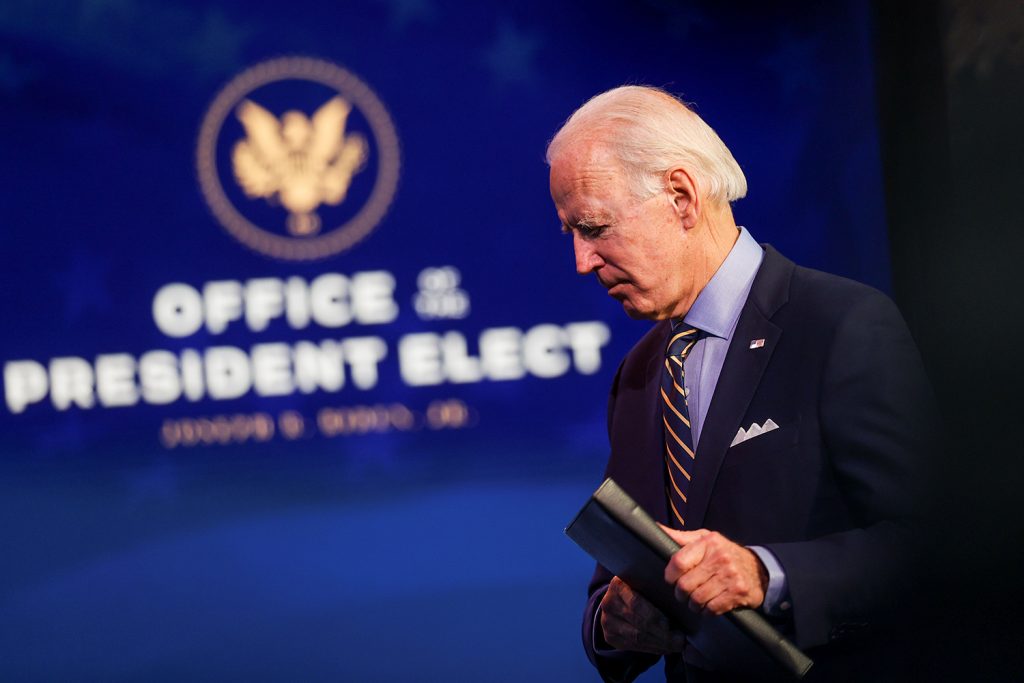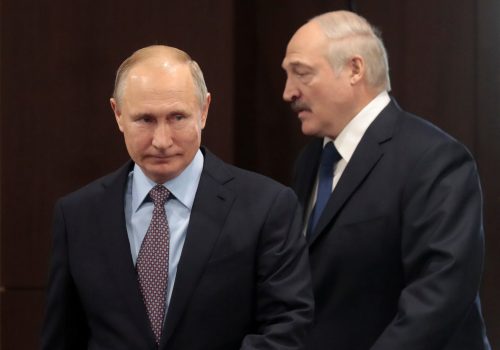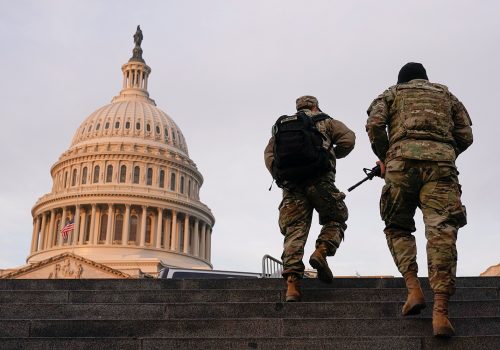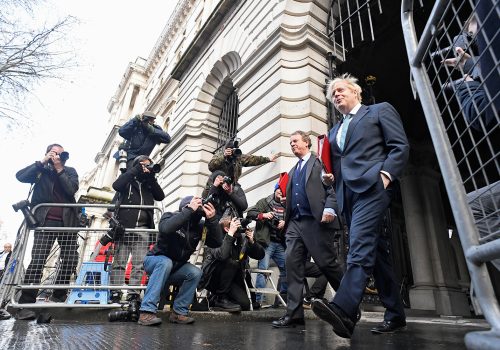It wasn’t US President Donald Trump’s intention, but he did his successor Joe Biden a potentially historic favor through his incitement of the violent insurrection at the US Capitol on January 6, for which the House impeached him for an unprecedented second time this week.
No right-minded individual would wish for that assault, which has resulted in five deaths and more than 100 arrests (and counting). However, it also served as a wakeup call, not only about the dangers posed by Trump’s refusal to accept his election defeat, but also about the increasingly toxic perils of America’s political, social, and racial divisions.
At the same time, the Capitol insurrection—and the political backlash that has followed—has increased Biden’s odds of becoming one of the rarest of political creatures: a US president of historic consequence. The past days’ events have greatly improved Biden’s chance of being the sort of transformative president who comes along only every generation or so.
“I think it makes my job easier,” Biden told reporters in Wilmington, Delaware two days after the Capitol Hill riot. “We must unify the country.”
Get the Inflection Points newsletter
Subscribe to Frederick Kempe’s weekly Inflection Points column, which focuses on the global challenges facing the United States and how to best address them.
Biden’s actions this past week underscored that he understands his opportunity and is in a hurry to seize it. At no point in my memory has a president-elect laid out such a detailed and ambitious plan even before his inaugural address.
His announcement of a $1.9 trillion American Rescue Plan on Thursday, followed a day later by the unveiling of a COVID-19 vaccination offensive, were both designed to produce measurable achievements during his first weeks in office to address Americans’ two predominant concerns: their health and their jobs. The fact that he’ll deploy a wartime law to ramp up vaccine production underscores his authority as commander-in-chief.
What’s most telling is the extent to which the economic plan was designed to be bipartisan, discarding some of the more controversial ideas among the party’s left. Those ranged from “baby bonds,” a proposed $1,000 savings account for every child born in the United States, to “automatic stabilizers,” which would kick in more budgetary support without legislative action should benchmarks be triggered.
Given the Democratic victories in both Georgia Senate run-off races this month, Biden could have chosen a more partisan path through fast-track rules known as reconciliation. That would have required just fifty-one votes—the fifty Democratic votes plus Vice President Kamala Harris as the tiebreaker in her role as president of the Senate.
But that approach would have launched the Biden administration on a divisive trajectory, defying his campaign pledge to be a unifier serving all Americans.
The reconciliation path also comes with restrictions: there are caps on how often it can be used during the year, and it is limited to tax and fiscal legislation. Finally, Biden knows that history’s lesson is that overreach in the next two years, with Democrats controlling both houses of Congress, could result in blowback at the ballot box in the 2022 midterm elections.
With all that in mind, Biden is wagering that he can land at least ten Republican Senate votes for the sixty he will need to pass his $1.9 trillion legislation.
He at the same time would be setting the table for further legislation, likely to be put forward in February, that will tackle his campaign goals of renewing American infrastructure, creating jobs, combating climate change, and advancing racial healing and equity.
So how has Trump been helpful to Biden’s ambitions, particularly with his actions of the past days?
First, though Republican legislators haven’t abandoned Trump in the numbers some had hoped, ten Republican members of the House joined the most bipartisan vote to impeach a president in US history. A growing number of Republican leaders are willing to distance themselves from Trump, who will now have a more difficult time avoiding prosecution and sustaining his party leadership role.
Second, the shock of January 6 and growing threats of extremist violence this week have stunned and frightened Americans who are now more eager to see effective, bipartisan governance in Washington. The inevitable economic growth of a vaccinated, stimulus-injected America in 2021 is also likely to shore up the Biden administration.
Beyond that, America’s allies were already suffering what one European diplomat calls “TTD—Trump Trauma Disorder.” They are even more keen now, having seen the dangers to American democracy in such stark relief, to embrace Biden. They understand the world faces an inflection point determining whether global democracies or Chinese-led autocracies will set future standards.
The internet is awash with lists of history’s greatest and most transformative American presidents. The one attached here, taken from a Business Insider survey of two hundred political scientists in 2019, is typical of the genre. Abraham Lincoln, George Washington, Franklin Delano Roosevelt, Harry Truman, and Ronald Reagan are all in the top ten. (Trump was ranked last.)
What the greats have in common is a historic challenge, not one of their own choosing, and the character to guide the nation through it.
Lincoln had the Civil War, FDR the Great Depression and World War II, Truman his post-war Marshall Plan and international institutions, and Ronald Reagan the decisive Cold War years. (I’ve always thought for that reason he should be viewed together with George H.W. Bush, who, as seventeenth on this list, is underrated).
Biden’s moment is of similar consequence, a defining moment not only domestically but also globally with China’s rise.
“President Biden is facing not only an economic crisis but also a political crisis, a cultural crisis, a public-health crisis and an epistemological one,” said historian Jon Meacham in the Wall Street Journal. “It’s immense and they’re all related.”
What Meacham is referring to with “epistemology” is that Americans no longer even agree to a common set of facts and realities, and that may be the most difficult bridge for Biden to build.
That brings us to character.
That’s what Americans will judge in his inaugural address this week, without their chosen social networks mediating. Without vilifying his predecessor, Biden will make the contrast through his words, designed to calm a nation, to be truthful about the challenges, and to lay out a unifying plan and vision.
Biden faces vast challenges, but Trump, through his actions of the past days, inadvertently made the president-elect’s job easier.
This article originally appeared on CNBC.com
Frederick Kempe is president and chief executive officer of the Atlantic Council. You can follow him on Twitter @FredKempe.
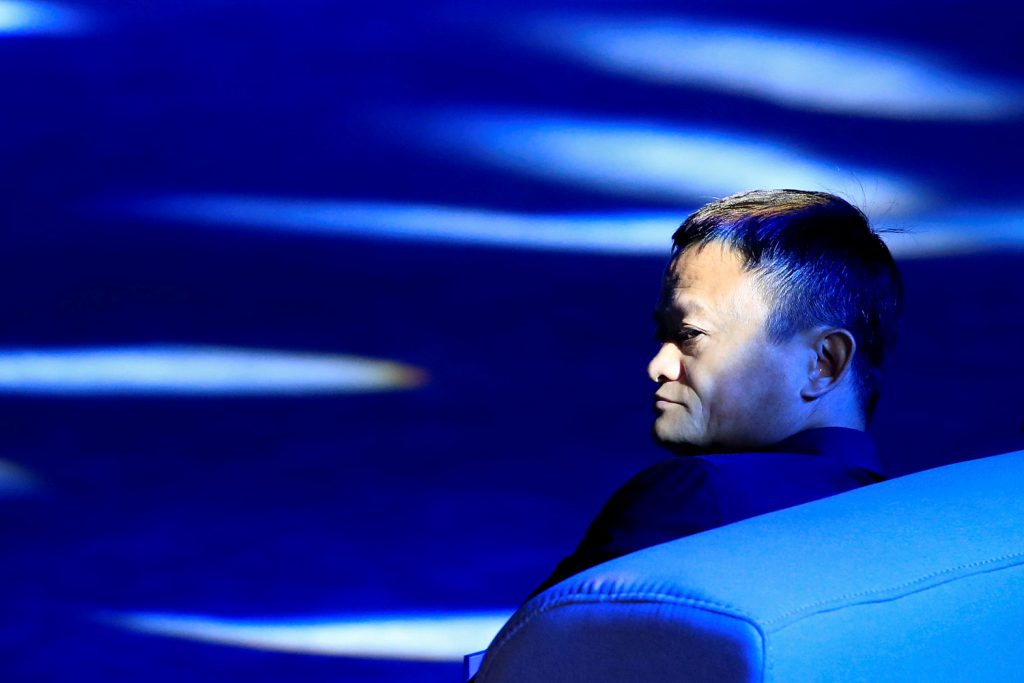
THE WEEK’S TOP READS
This week’s top reads begin with Jerry Seib’s brilliantly reported cover story of the weekend WSJ’s Review section, looking at how Trumpism took over the Republican party and examining the party’s future options.
Then don’t miss Kurt Campbell and Rush Doshi’s piece in Foreign Affairs on America’s best course in the Indo-Pacific. Campbell’s appointment to become “Indo-Pacific czar” in the Biden administration makes this essay all the more relevant.
To understand what’s behind President Xi Jinping’s clampdown on China’s biggest private business, read the FT’s “big read” on Xi’s feud with billionaire Jack Ma as well as Michael Schuman’s investigation in the Atlantic. This is an underappreciated story.
This week’s two must-reads take deeper looks at the events of January 6.
Historian Timothy Snyder in his New York Times cover story looks at the role of the post-truth era in bringing on “the American abyss,” building on my own piece of two weeks ago on what we can learn from the abyss. He blames Republican “gamers” and “breakers”—legislators who wanted to leverage Trump to their advantage and others who wanted to break the system altogether.
This week’s second must-read comes from the New Yorker’s Luke Mogelson, who provides the best front-line account I’ve read yet of what happened inside the Capitol on the day of the insurrection.
#1. THE REPUBLICAN FUTURE
Where Trump Came From—and Where Trumpism Is Going
Gerald F. Seib / THE WALL STREET JOURNAL
One of the most significant questions in the months and years ahead is what will become of the Republican Party following the Trump presidency.
The Wall Street Journal’s Jerry Seib provides the smartest reporting and reflection yet on the forces that created Trump and the dilemmas the Republican Party faces as it begins to map its future.
“Ultimately, a movement born of many Americans’ legitimate concerns about the effects of economic globalization and feelings of alienation from the nation’s political, cultural and financial elite,” writes Seib, “was overwhelmed by Mr. Trump’s need to find enemies and grievances—and the bond he chose to build with those on the outer edges of society who shared that tendency.”
Seib traces the roots of Trumpism and explores whether Republican leaders “can sort through the debris and carry forward a more mainstream version of the message.” Read More →
#2. THE SEARCH FOR AN INDO-PACIFIC STRATEGY
How America Can Shore Up Asian Order
Kurt M. Campbell and Rush Doshi / FOREIGN AFFAIRS
This one is worth reading not only for its substance, which is rich, but also because it was co-written by Kurt Campbell, who will join the Biden administration as what some are calling its “Indo-Pacific czar.” His more formal title will be deputy assistant to the president and coordinator for Indo-Pacific affairs on the National Security Council.
I can think of no one more qualified for that demanding job at this historic time.
History can be a great guide to understanding politics, and few people have a better grasp of both than former US Secretary of State Henry Kissinger. That’s why Campbell and Rush Doshi turned to Kissinger’s writing—in this case, his early dissertation on the power struggles of nineteenth-century Europe—to make sense of the situation in the Indo-Pacific today.
Writing in Foreign Affairs, the authors suggest that “a strategy for the Indo-Pacific today would benefit from incorporating three lessons from this episode of European history: the need for a balance of power; the need for an order that the region’s states recognize as legitimate; and the need for an allied and partner coalition to address China’s challenge to both.”
Now Campbell can put those concepts to work. Read More →
#3. XI’S SQUEEZE ON CHINA’S PRIVATE SECTOR
Jack Ma vs Xi Jinping: the future of private business in China
Tom Mitchell, Yuan Yang, and Ryan McMorrow / FINANCIAL TIMES
The Undoing of China’s Economic Miracle
Michael Schuman / THE ATLANTIC
As President Xi Jinping continues his crusade to assert ever more control over China, the fate of the country’s biggest private businesses, which have contributed so much to China’s economic success, is now more uncertain than ever. Just ask Jack Ma.
In a FT big-read this week, Tom Mitchell, Yuan Yang, and Ryan McMorrow detail what happened to Jack Ma, who was, until recently, China’s richest man. Shortly after giving a speech in October that criticized the government’s business policy, his company Ant Group was prevented from holding what was supposed to be the world’s largest IPO—reportedly at Xi’s personal instruction.
“The stand-off, which has sparked rampant speculation about Mr. Ma’s whereabouts could become a defining moment for the future of private business in Mr. Xi’s China,” the authors say. Read More →
Michael Schuman warns in the Atlantic that Xi’s moves inward could have “serious consequences for China’s economic progress, and its relations with the world.”
“By favoring the state sector, Xi is funneling valuable money and talent to notoriously bloated and inefficient government enterprises instead of far more nimble and creative private firms. The negative effect shows up in miserably poor productivity—a disaster for an aging society still catching up with the richest nations—and mounting debt, now nearly three times the size of national output.” Read More →
#4. GAMERS AND BREAKERS
The American Abyss
Timothy Snyder / THE NEW YORK TIMES MAGAZINE
Timothy Snyder, the brilliant author and historian, applies his knowledge of the past to examine our frightening present. His long-form essay on Trump and the rising dangers to American democracy should be a must-read in every US classroom.
He divides the Republicans who have enabled or supported Trump’s lie that Biden won fraudulently into “the gamers and the breakers.” One group has merely wanted to game the system (think Senator Mitch McConnell) while the other is determined to break it (think Senator Josh Hawley).
But here’s Snyder’s real point, drawn from history: “Post-truth is pre-fascism, and Trump has been our post-truth president. When we give up truth, we concede power to those with the wealth and charisma to create spectacle in its place.” Read More →
#5. INSIDE THE INSURRECTION
Among the Insurrectionists
Luke Mogelson / THE NEW YORKER
As the United States continues to grapple with what happened at the Capitol on January 6, the New Yorker’s Luke Mogelson delivers this week’s page-turning, brilliantly reported must-read from the front lines.
His first-person account, including his own twenty-minute incapacitation from pepper spray, is the richest account I’ve read yet chronicling the conversion of Trump supporters at the morning rally into a mob that stormed the Capitol.
“When I regained my vision,” he wrote, “the mob was streaming freely through all doors. I followed an overweight man in a Roman-era costume – sandals, cape, armguards, dagger… “
At another point, he writes, “Many people were equipped with flak jackets, helmets, gas masks, and tactical apparel. Guns were prohibited for the protest, but a man in a cowboy hat, posing for a photograph, lifted his jacket to reveal a revolver tucked into his waistband. Other Trump supporters had Tasers, baseball bats and truncheons. I saw one man holding a coiled noose.”
This one is worth reading in its entirety.
The author makes clear that we don’t yet know how this story ends, as the extremists involved may be further isolated but also further inspired by the event. Read More →
QUOTE OF THE WEEK
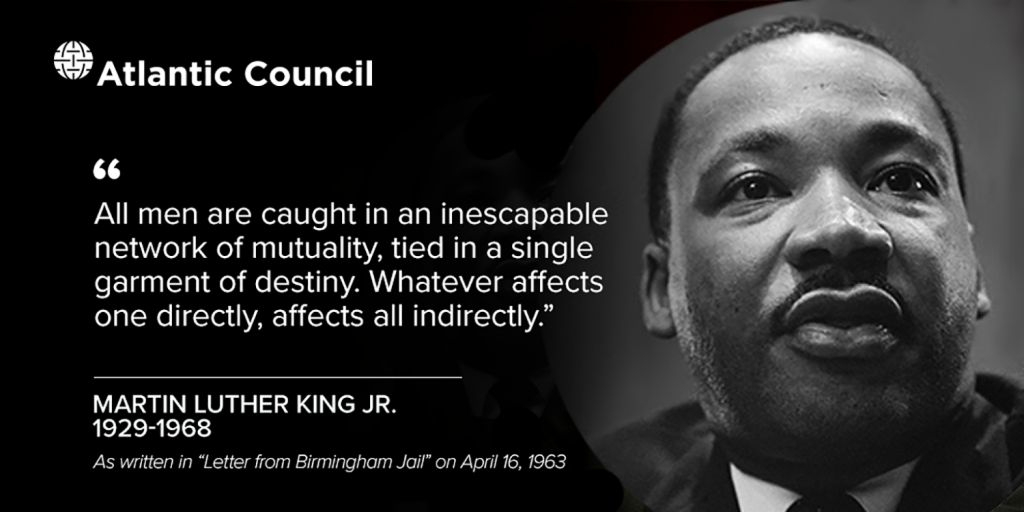
Atlantic Council top reads
Image: U.S. President-elect Joe Biden leaves after delivering a speech at his transition headquarters in Wilmington, Delaware, U.S., December 28, 2020. REUTERS/Jonathan Ernst
